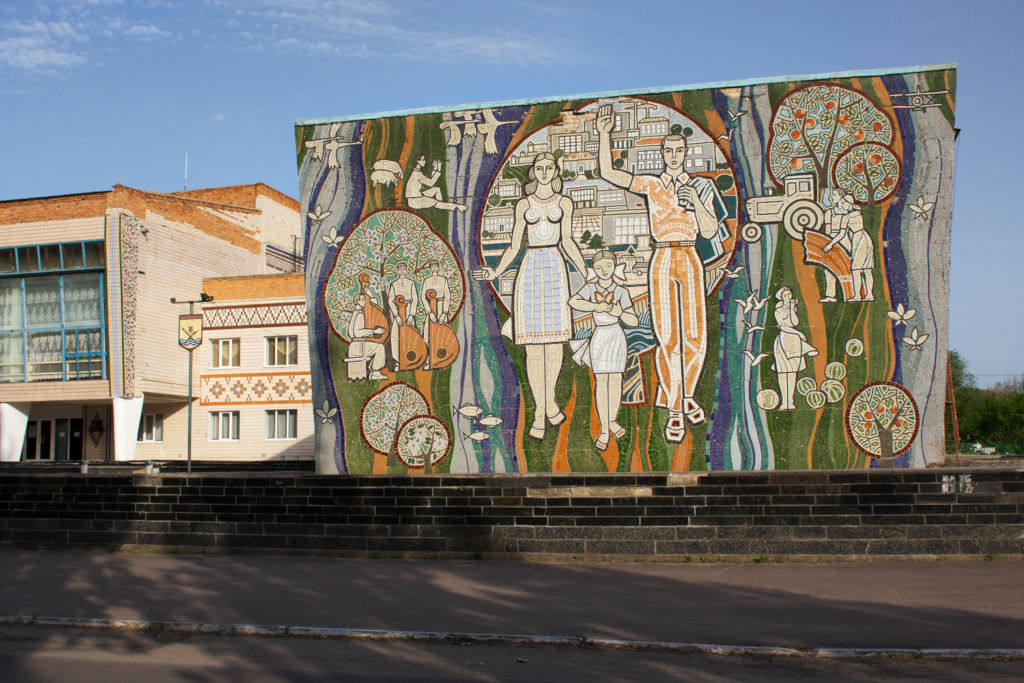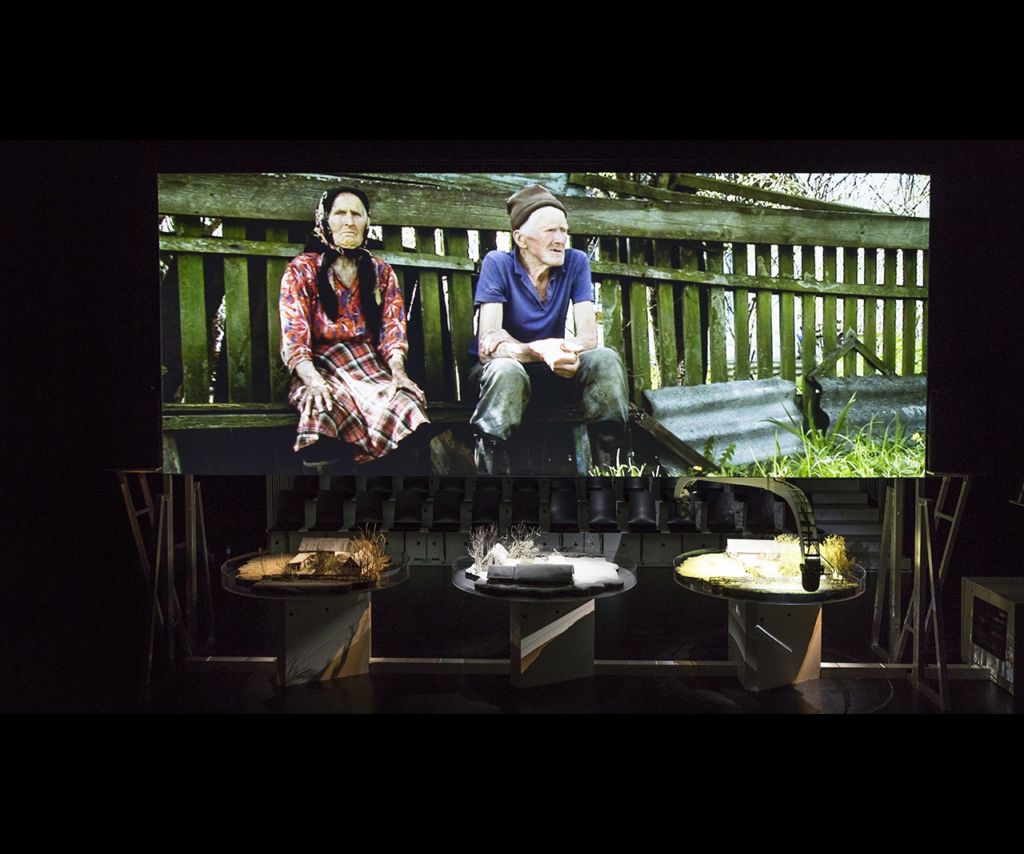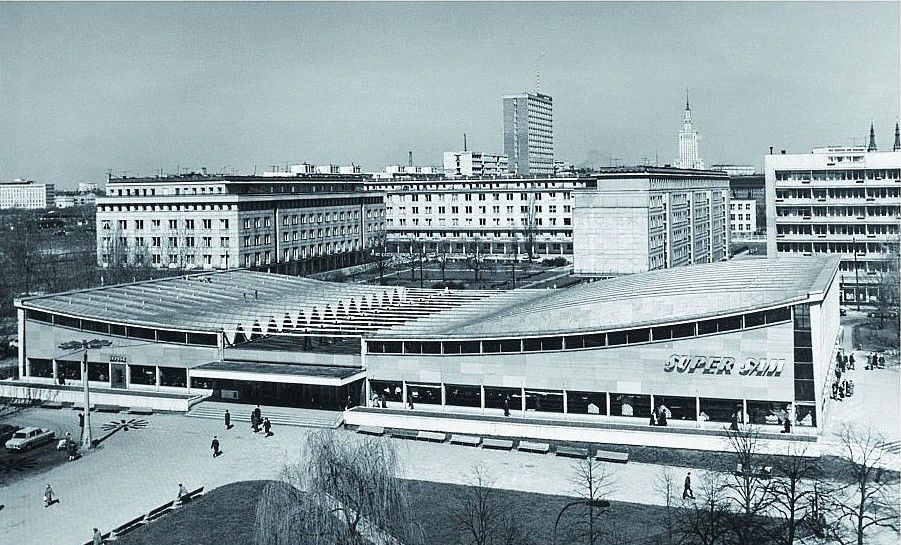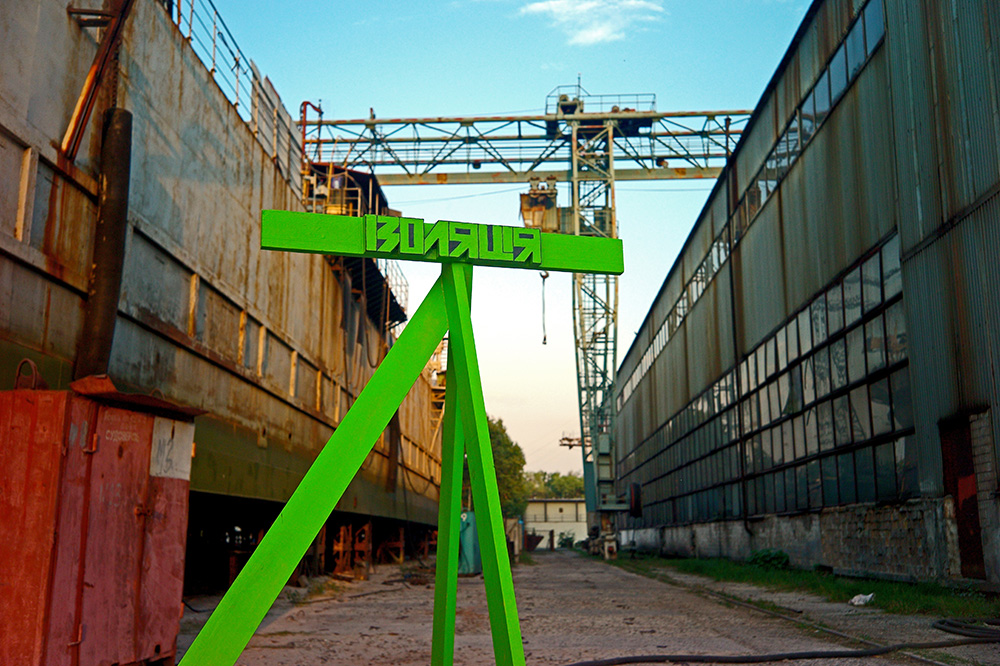The Past Living in the Future: Ukrainian Politics of Memory in Visual Arts after Maidan
The mechanism of forgetting about the Soviet past, through the erasure of the physical remnants of the former system, was particularly strong in Ukraine in the past years. Today, a war of remembrance is raging, as many Soviet monuments and other relics of Soviet history are destroyed. The future of Ukraine is to be constructed on the basis of a particular picture of the past.
Texte disponible uniquement en anglais
Taras Kuzio, History, Memory and Nation-Building in the Post-Soviet Colonial Space, in Nationalities Papers, 30 (2), 2002, 241-264.
Ibid.
Ibid.
Gayatri Chakravorty Spivak, A Critique of Postcolonial Reason: Toward a History of the Vanishing Present (Cambridge MA: Harvard University Press, 1999), 1-3, and Robert J. C. Young, Postcolonialism: A Very Short Introduction (Oxford: Oxford University Press, 2003).
Serhii Plokhy, The Gates of Europe: A History of Ukraine (New York: Basic Books, 2015).
In 2015 the Verkhovna Rada of Ukraine adopted the law “On immortalisation of victory over Nazism in World War II of 1939-1945.” The act replaces the phrase “Great Patriotic War” with “Second World War,” which bears a symbolic significance as it is a deliberate break from the Soviet-Russian narrative. It also marks the changes in policy in memory building after the Euromaidan, directed more towards Europe. For more, see Adrianna Rybak, “Ustawy dekomunizacyjne na Ukrainie,” in Polityka / Komentarze, No. 8, 2015 (Lublin: Centrum Europy Wschodniej, 2015).
Aleksander Milov (b. 1979 in Odesa, Ukrainian SSR) is a visual artist, film maker and sculptor. instagram.com/alexandermilov
Niels Ackermann (b. in 1987 in Geneva, Switzerland) is a photographer living between Geneva and Kyiv. L’Ange Blanc, his report on post-Chernobyl youth, brought him many awards including the Prix Rémi Ochlik-Ville de Perpignan and the Swiss Press Photo Award. nack.ch
Sébastien Gobert (b. 1985 in Lagny-sur-Marne, France) is a French journalist living in Ukraine. He is a correspondent for, among others, Libération, Radio France Internationale, Le Monde Diplomatique, and La Tribune de Genève. His work was awarded the Writing for CEE prize in 2013. nouvellesest.com
Yevgen Nikiforov (b. 1986 in Vasylkiv, Kyiv Oblast, Ukrainian SSR) is a photographer currently based in Kyiv. He works on independent documentary projects such as Ukrainian Soviet Mosaics (2013-2020) and On Republic’s Monuments (2014-2019).
Zhanna Kadyrova (b. 1981 in Brovary, Ukrainian SSR) is an artist living in Kyiv. She is co-founder of the group R.E.P (Revolutionary Experimental Space) and member of the music group Penoplast. She received the Special Award of the Pinchuk Art Prize in 2011 and the Malevich Prize in 2012. Kadyrova is the author of video works, installation and performance, she also works with painting, drawing and sculpture.
Mykola Ridnyi (b. in 1985 in Kharkiv, Ukrainian SSR) is an artist, filmmaker, curator and author of essays on art and politics based in Kyiv. He is one of the founding members of the SOSka group and the SOSka gallery-lab in Kharkiv (closed in 2012) and a co-editor of Prostory—online magazine about visual art, literature and society.
David Chichkan (b. in 1986 in Kyiv, Ukrainian SSR) is an artist and activist. In the years 2010-2016 he was a member of the Ukrainian anarchist organisation The Autonomous Workers’ Union, and since 2014 he has been a member of the libertarian organisation Black Rainbow. He is the creator of the LCUD (Libertarian Underground Dialectics Club) research project on right-wing ideology in Ukraine.
DE NE DE is an initiative founded in 2015 in Ukraine that explores ways of representing history in public space. It has implemented a number of projects exploring the processes of decommunisation in different regions of Ukraine. Focusing on urban transformations during decommunisation, DE NE DE offers a creative rethinking of the Soviet heritage.
Yevheniya Molyar is a cultural activist, working with the collection of the Kmytiv Museum of Fine Art.
Leo Trotsenko is a cultural activist and artist, working with the collection of the Kmytiv Museum of Fine Art.
Alla Horska (b. 1929 in Yalta, d. 1970 in Vasylkiv, Ukrainian SSR) was a ukrainian artist and dissident, representative of the underground art movement. She was part of the Sixtiers movement.
Ilya Kabakov (b. 1933 in Dnipropetrovsk, Ukrainian SSR) is an artist living in Long Island, USA. Former “official artist” of the Soviet Union and book illustrator, he later became a conceptual and experimental artist, working with his spouse Emilia Kabakov.
Anatoliy Belov (b. 1977 in Kyiv, Ukrainian SSR) is an artist living in Kyiv. He is co-founder of the group R.E.P (Revolutionary Experimental Space). His works often comment the themes of non-heteronormativity, with the use of queer and camp aesthetic. Member of music groups Ludska Podoba and Chopa-Cupacabra. He works with drawing, painting and video art.
Lada Nakonechna (b. 1981 in Dnipropetrovsk, Ukrainian SSR) is a visual artist and curator living in Kyiv. She uses various artistic means, such as drawings, photographs, installations, and performances. She is co-editor of Prostory.net.ua, and a member of the curatorial and activist union Hudrada as well as the R.E.P. (Revolutionary Experimental Space) group.
Vlada Ralko (b. 1969 in Kyiv, Ukrainian SSR) is an artist living in Kyiv. She is the author of big scale paintings, as well as drawings. She often comments on female intimacy, sexuality and body.
Vova Vorotniov (b. 1979 in Kyiv, Ukrainian SSR) is an artist and activist connected with the graffiti scene living in Kyiv. He conducts urban ethnographic research, in which he focuses on the disappearing traces of Soviet material culture and its transformation into post-Soviet forms.
El Lissitzky (b. 1890 in Pochinok, Russian Empire, d. 1941 in Moscow, Russian SFSR) was an important artist, designer, photographer, typographer and architect within the Russian avant-garde. He also designed numerous displays and propaganda works for the Soviet Union. Inspired by the suprematism of Kazimir Malevich, he has developed his own variant—Proun.
In Neoplasm, Kadan works with the characteristic structures resembling El Lissitzky’s Prouns to create modern maps of the areas in Kyiv and Yekaterinburg that have undergone the process of gentrification. In the case of Yesterday, Today, Today, the artist criticises the commercialisation of the public space of the Kyiv metro.
The revolution started on 7 November 1917, but is referred as the October revolution because according to the so-called Old Style calendar the date was 25 October.
Dieter Roelstraete is an art critic and curator at the Neubauer Collegium for Culture and Society at the University of Chicago. His curatorial interests concern the relationship between art and politics, art as a species of knowledge, art work as intellectual labor, and the conception of exhibition-making as a form of writing.
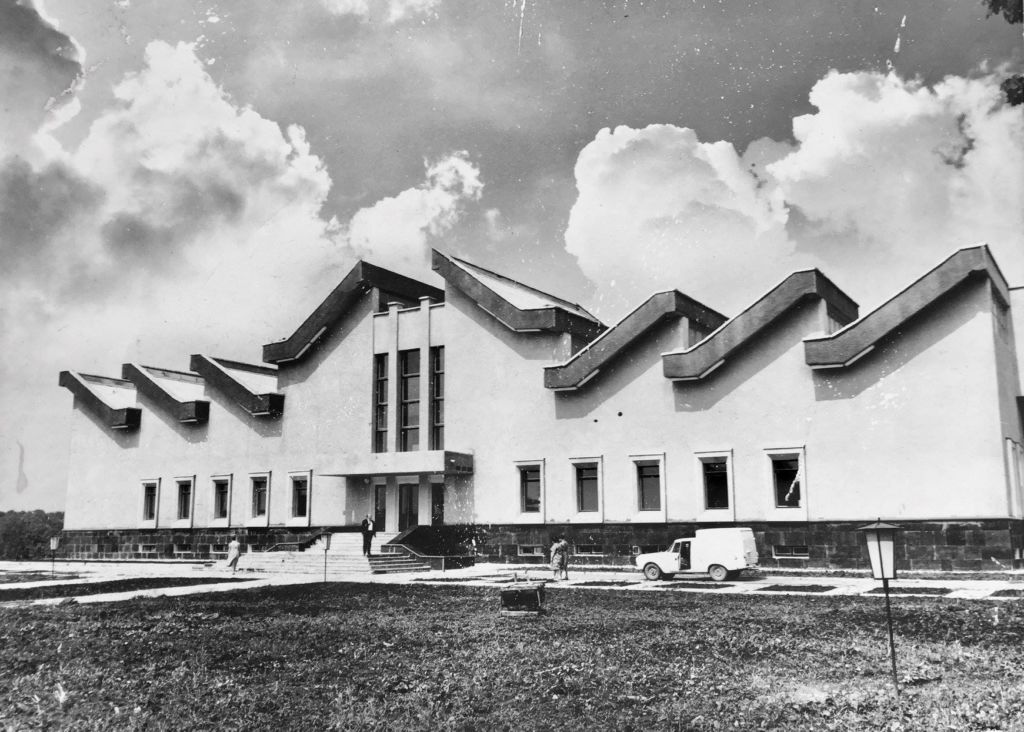
Kmytiv Museum of Soviet Art
Post-Sovietness and Post-colonialism
It can be argued that Ukraine is a postcolonial country. A debate is going on in the academic community whether this expression can be used for countries that were not colonies in the literal sense. The term “colony” is traditionally used to refer to non-European territories exploited by and belonging to the European empires. Ukraine, an immediate neighbour of Russia, was part of the USSR, an equal entity, at least theoretically, but the reality was somewhat different.
Some of the policies applied in the Soviet republics by the government in Moscow were essentially very similar to those imposed by the Western colonial powers. The former Soviet states, therefore, had to face up to the removal of similar inherited colonial legacies as post-colonial states in Asia, or Africa.1 The Soviet Union, just like the colonial empires, was constructed around a main central area—Moscow, which controlled the “peripheries,” the non-Russian republics, in political, cultural and economic aspects.2 Along with Marxism-Leninism, Russian imperialism was the leading ideology, which included the definitions of Russians as the “leading nation” and the “elder brothers” for the other fourteen republics. This cultural hegemony is an important factor, as the Russians were taught that the whole Soviet Union was their homeland, and so the Russian identity was confused with the Soviet one—all inhabitants were the Soviet people, yet it was the Russian culture and language that were dominant.3 In Ukraine, where the hegemony of the Russian culture was strongly applied, the language and culture were treated as a “folk” deviation of the one true Russian culture. The historiography was also Russo-oriented. This is why reclaiming one’s own past became so important in the post-Soviet countries, especially Ukraine—the individual nation’s past is necessary to form the nation’s own and independent identity.
As the term “post-colonial” is problematic, suggesting that colonialism is no longer present in the place in question, certain scholars have proposed the term “neo-colonialism,” which is closer to reflecting the actual relations between the “colony,” which regained its independence, and the “power,” on which it is still, in a certain sense, dependent.4 The post- or neo-colonial approach is questionable itself, as it places the region in an objectifying context. In any case, Ukraine is a post-Soviet and a post-/neo-colonial country, its complicated relations with Russia and their shared past to a great extent determine the questions about the future.
The past is problematic in Ukraine for several reasons. Independent Ukraine has existed as a country for less than three decades. Yet the history of the Ukrainian nation stretches back to the distant past—the Ukrainian lands were inhabited by the Scythians, whose culture dates back to 7th century BC. In the 5th and 6th centuries AD the lands were inhabited by the Antes, ancestors of the Ukrainians. The brightest points of the lands’ history include the Kievan Rus’, between the 9th and 13th centuries, and the Hetmanate in the 17th and 18th centuries. Since the collapse of the Kievan Rus’, however, Ukrainian history is one great struggle and a constant fight for independence—either from Polish or from Russian hegemony. The victory was close in 1917, with the proclamation of the Ukrainian People’s Republic, but wasn’t achieved until the collapse of the Soviet Union in 1991.5
The Ukrainian nation has existed for centuries but the modern state, however, has been confined to five years in the first half of the 20th century and slightly less than thirty years since its independence. Despite being an artificial construct tending to generate markers of “national homogeneity” leading to an unnatural standardisation of actual diversity, this concept is, so far, faring well in places which, after years of oppression and foreign intervention, must establish their own nationality and statehood. Another problem is the complex historical narrative. For example, during the Second World War, Ukrainians fought in the ranks of the Red Army against the fascist occupants. At the same time, the nationalist Ukrainian underground battled against the Soviets, even collaborating with the Nazis. The Russian narrative of a great victorious war, the so-called Great Patriotic War, is a great problem for Ukraine, as its role in the victory was blurred with the Soviet one, and, at the same time, the tragedy of the Ukrainian lands, devastated by the warfare, was underestimated.6
On the one hand, Ukrainians want to see themselves with the winning side, while on the other, they construct their own history on the basis of nationalist heroes. This leads to the production of mutually exclusive narratives—like a situation in which the same person is a hero fighting the Nazis and a Soviet general too. The “mess” of the historical narrative has led to absurdities, such as the proximity between the monuments to the Holodomor, the great manmade famine engineered by the communist authorities in 1932-1933, and those erected to honour the Red Army. In the dramatic situation caused by the ongoing conflict with Russia in Donbas, the Ukrainian government decided to tidy up the past.
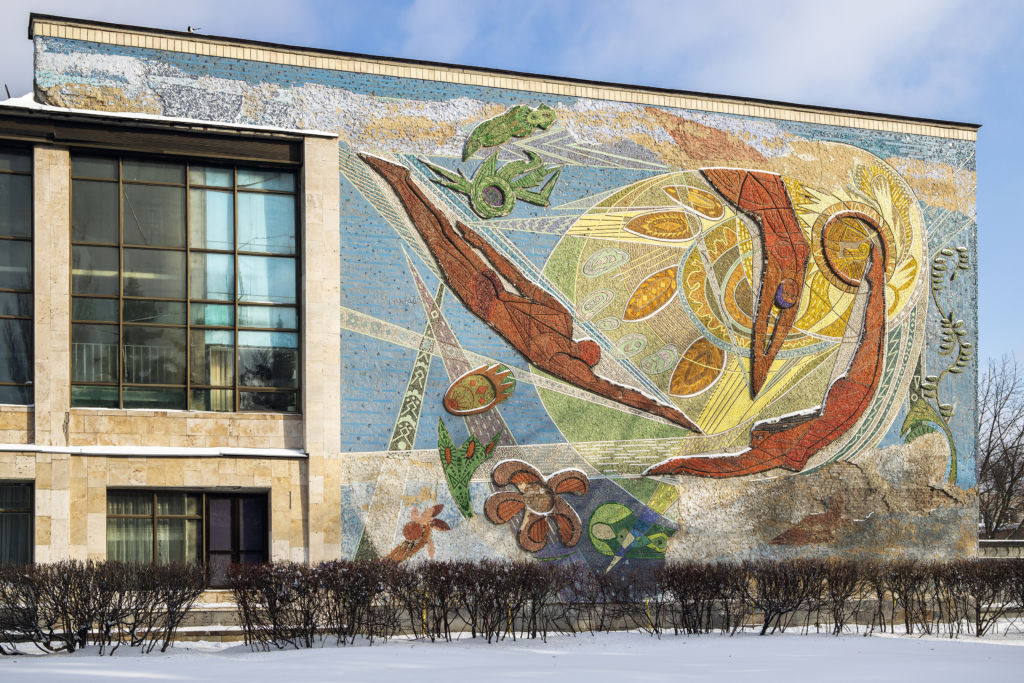
Yevgen Nikiforov, from the series « Decommunised: Ukrainian Soviet Mosaics
Decommunisation and the New Politics of Memory
In its attempts to separate itself from Russian influences in the difficult socio-political situation of the mid-2010s, Ukraine as a state opted to reduce and erase unwanted elements and to glorify desired ones. With the extensive decommunisation programme introduced in 2015 came a turn towards the Ukraine’s nationalist history in official politics of memory. Both tendencies were largely the doing of Volodymyr Viatrovych, appointed director of the Ukrainian Institute of National Remembrance in 2014. His actions were the driving force behind the so-called decommunisation laws, which aim to regulate how to speak about the past. Viatrovych was also involved in constructing a positive image of national heroes and nationalist organisations from the Second World War era such as Stepan Bandera, the Organisation of Ukrainian Nationalists, and UPA Ukrainian Insurgent Army, ignoring their collaboration with the Nazi authorities, ethnic purges of the Polish population in Volhynia and the local nature of these organisations, which operated only in Western Ukraine. Imposing a narrative characteristic of less than half of the country is a devastating abuse. Another marginalised factor was the strong anarchist movement, with its symbol—Nestor Makhno, with whom people, other than right-wing or nationalists, could identify with.
An interesting aspect is that decommunisation became one of the most visible consequences of Maidan, next to the annexation of Crimea by Russia in 2014 and the ongoing war in Donbas. Caused by President Viktor Yanukovych’s policy, which prevented the European Union Association Agreement from being signed by Ukraine, the revolution turned out to be not so much pro-European as anti-Soviet. A process of erasure from public spaces of all physical remnants of the old system began. On 9 April 2015, the Supreme Council of Ukraine passed four laws concerning the politics of national memory—the so-called decommunisation laws. As well as helping to shape the new historical policy, they also clearly pointed to the flashpoints and painful aspects of Ukrainian thinking about the past and building a new future for the country, free from Soviet rhetoric. The first law regulates the rules of state policy concerning access to archival information. The second refers to fighting against the Nazi regime during the Second World War—including the participation of Ukrainian combat organisations. The third, initiated by Viatrovych himself together with Shukhevych, is an attempt to regulate discussion of veterans and participants in the struggle for Ukraine’s independence. Interestingly, this also applies to foreigners. The law foresees penalties for denying the legality and legitimacy of the actions of “fighters for Ukraine’s independence.” It also expands teaching curricula to include this aspect. The final law directly concerns decommunisation of Ukraine’s public space. Its implementation entailed removal of monuments and memorial plaques, change of street names, institutions, and even cities which commemorated communism. The law demanded immediate action—local authorities had six months from its implementation to conform to its directives. The result caused upset and controversies—over the next three years, almost 2,000 monuments were removed and around 50,000 names of squares, streets and towns were changed. The question of why this had only happened now, and not decades earlier, as in some of the other post-Soviet republics, also remained. It is hard to escape the conclusion that this was conscious decolonisation combined with indigenisation, which in Ukraine’s case meant increased interest in nationalist, “true Ukrainian” heroes and their actions. Taking into consideration Ukraine’s tragic history, in terms of its independence, and the difficult and slow de-Sovietisation process after 1991, Maidan unleashed emotions that had been suppressed for years.
Contemporary Iconoclasm
The need to form Ukrainian mythology came together with an iconoclasm equal to that with which the communist atheist state dealt with objects of religious cult a century before. The vast majority of Ukrainian artists are not convinced that it is right to destroy Soviet heritage. Nikita Kadan7 proposed that the monuments of communism should remain where they are, accompanied by explanatory inscriptions, in order to create an open-air museum of ideology and propaganda. Another idea, following the Hungarian example, would be the creation of a Soviet statue park. No such solution was chosen. Between December 2013 and September 2015, Leninopad, or “the fall of Lenins,” took place, when 1300 monuments to the Soviet icon were destroyed. The statues had their heads, hands or feet removed, were damaged by blunt instruments, or even sunk in rivers. The monument in Odessa was converted into a statue of Darth Vader by the artist Aleksander Milov.8 In Kyiv, the IZOLYATSIA cultural platform organised a two-year action around the empty plinth featuring artists from around the world. Niels Ackermann9 and Sébastien Gobert10 travelled around Ukraine searching for the remains of the monuments, presenting their account in the photo book Looking for Lenin. In his publication On the Monuments of the Republic the photographer Yevgen Nikiforov11 documents the wider phenomenon of mass destruction of Soviet memorials. Demolition of monuments is nothing new. In Moscow, after the October Revolution, the statue of Tsar Alexander III was toppled, the head cut off and the body dismembered. The mass demolition of monuments in Ukraine and the attendant emotions are therefore connected to a much deeper theme—reconciliation with the past in order to be able to look into the future.
In 2017 Zhanna Kadyrova12 produced the project Recanonisation. In a series of works, she returned to the 1920s when the iconoclasm of the communist government targeted at objects and places of religious worship. Churches, statues and icons were destroyed en masse and eliminated from the public space, in an attempt to erase them from people’s consciousness and memory. Kadyrova sees a parallel between these practices and today’s anti-communist iconoclasm in Recanonisation, perversely juxtaposes these two moments of Ukrainian history. The artist chose a bust of Ivan Bevz, an activist of the Soviet anti-fascist underground who lost his life in 1943 for his activity against the Third Reich, as her object. As a communist activist, Bevz ought to be erased from historical memory, but as someone who fought for Ukraine’s freedom, he is a hero. Kadyrova placed a golden halo on the head of Bevz’s stone bust, lending it the attribute of a saint, something that would have been destroyed a century earlier. In the Expocentre pavilion in Kyiv, which contains Soviet reliefs with images of milkmaids and shepherds, the artist also ringed their countenances with halos; like Bevz, they too could be destroyed on account of their links to the previous system.
Monument to a New Monument, a work by Kadyrova from 2009, is an interesting precursor of decommunisation produced in Sharhorod in the Vinnytsia region. The structure, erected on the town square, was made of the slabs that were typical of Soviet times and are characteristic of many of Kadyrova’s works. It depicts a figure covered in a white tarpaulin—it is a statue of a statue about to be unveiled. Anybody can fill it with their own expectations for what the monument might be. To knock down and put up statues is to control collective memory in a way that can result in a rapid process of glorification or consignation to oblivion. The artist seems to be asking whether it might not be better to leave the statue covered up to avoid its destruction. Another project by Nikita Kadan, Pedestal. Practice of Exclusion (2009-2011), is an installation consisted of an enormous pedestal assembled in such a way as to not leave any space in the room for either the statue or the viewer. This repressive form emphasises the power given to statues. Power over memory, destruction or preservation. Also the 2011-2013 project by Mykola Rydnyi13 is devoted to the same subject. His sculptures Platforms and a documentary film Monument comment on the phenomenon of the continuous dismantling old monuments and constructing new ones.
David Chichkan14 tells of the absurd side of decommunisation in a series of watercolours on paper from 2017. Although the decommunisation law itself concerns objects produced after the October Revolution, it contributed to the destruction of works generally regarded as communist. Chychkan shows that this label could easily be used for figures from Ukraine’s history who are today viewed as national symbols—such as Lesya Ukrainka or Ivan Franko, who had socialist views but are associated with national-liberationist ideas. In his works, Chychkan presents their statues destroyed by radical-right-wing activists—a hypothetical event, yet one that is entirely possible in the atmosphere reigning in the country at present. The iconoclasm here concerns not only the past, but the present too—Chychkan’s 2017 exhibition at the Visual Culture Research Centre in Kyiv, titled Lost Opportunities, was itself destroyed. It was demolished by activists of rightist organisations who objected to its criticism of Maidan—or rather its consequences: the reclaiming of the national and identity discourse by right-wing activists and the single correct narrative imposed.
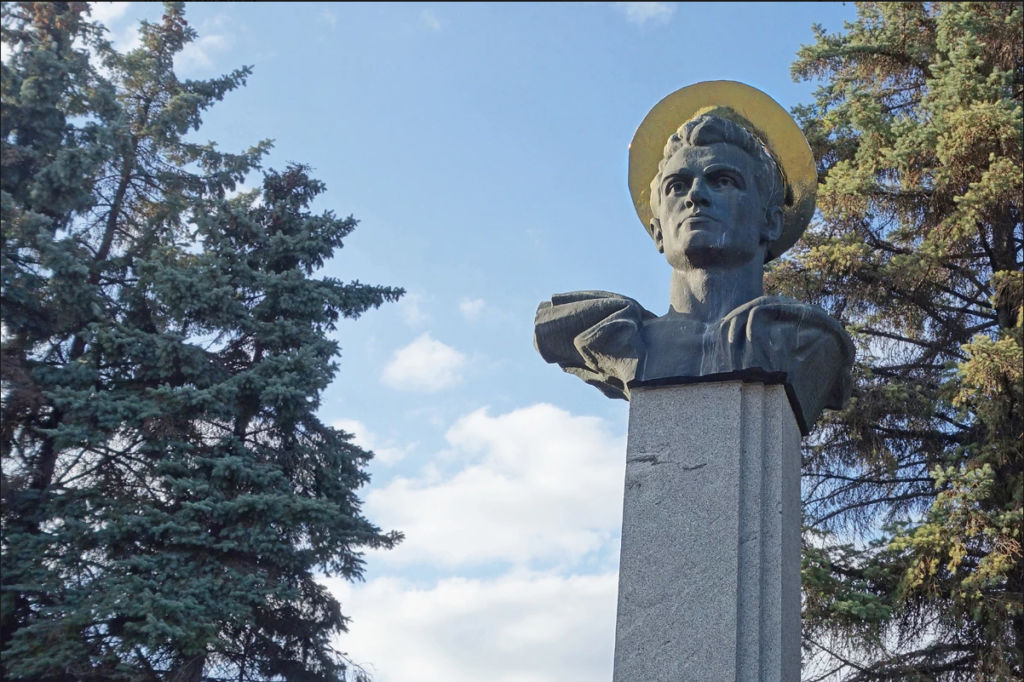
Zhanna Kadyrova, Recanonisation, 2017
It is not only statues that decommunisation swallows up. Another endangered branch of art is mosaics, which blossomed at the time of the Soviet Union. Characteristic Soviet mosaics fall into ruin or are deliberately removed from the city space. Yevgen Nikiforov has worked painstakingly to document them in his photo book Decommunized: Ukrainian Soviet Mosaics (2017) which is cataloguing three years of travelling around Ukraine, as well as Crimea and the Donbas.
Preserve As Much As Possible
Ukraine’s mosaics, and monumental art in general, are also an interest of the collective DE NE DE.15 The group focused on the activity of often forgotten local museums in small towns outside of the main cultural circulation. The searches for forgotten mosaics made by Yevgen Nikiforov and DE NE DE introduce the desire to reclaim and increase awareness of peripheral places that are falling into oblivion, not just because of official policy but as a result of the natural mechanisms of memory. Nikita Kadan is particularly interested in these mechanisms—ways of talking about and archiving the past. Since 2019 Kadan, together with Yevheniya Molyar16 and Leo Trotsenko,17 has been working on the research and exhibition platform of the Department of Contemporary Art at the Joseph Bukhanchuk Museum of Fine Art (until 1991 the Museum of Soviet Art) in Kmytiv, Zhytomyr region. The museum holds a collection of almost 3,000 paintings, graphics, sculptures and items of decorative art from the second half of the twentieth century from former Soviet republics. Rather than destroying, hiding or separating the Soviet artistic legacy like a strange “foreigner,” it maintains a lively correspondence with the current art. The exhibitions juxtapose the works of such artists as Alla Horska18 and Ilya Kabakov,19 produced during Soviet times, with the contemporary art of Anatoliy Belov,20 Lada Nakonechna,21 Vlada Ralko22 and Vova Vorotniov.23 Their work makes a symbolic point that the authorities cannot grasp—that this is one heritage. In August 2019, right-wing politicians began to intervene in the museum’s work with the desire to influence its output. The right-wing attacks on the museum’s work show what kind of narrative is dominant today in official political circles of Ukraine. The inability to work with the history is resulting in absurdities.
Kadan works with the past, memory and archives as the main representative of a movement in contemporary Ukrainian art that has become known as “new archivism.” Even before Maidan, war in the Donbas and decommunisation, he produced projects such as Yesterday, Today, Today (2012), the subject of which is the Kyiv metro, a Soviet complex, or Neoplasm (2010), which alludes to the works of Russian avantgardist El Lissitzky.24 In both cases, the works concern criticism of capitalism,25 but their core is linked to the material of the past itself as an important point in Ukrainian identity, the past shaping the present. In 2016 Kadan prepared a replica of a metal element decorating the Voksalna station to cover the 1960 bronze relief commemorating the 1917 October Revolution.26It was produced by metro staff in accordance with the newly implemented decommunisation laws. Kadan called his work Ryza—a decorative metal covering for icons, three-dimensional replicas of the painted elements, mirroring the figure’s clothing and outline, leaving only the face and hands uncovered. Made out of valuable materials they are used for protection and veneration—of the icon itself as well as the saints they represent. The metal cover produced by the metro staff was meant to cover, and thereby erase memory. Its replica perversely preserves what it is concealing, becoming a means of protection of a deleted narrative.
Accept the Past, Look into the Future
The Possessed Can Witness in Court (2015) is a work by Nikita Kadan presented at the National Museum of History of Ukraine. The installation comprises old shelves resembling archival or museum stands with artist’s works and objects from the museum collection related to the Soviet history of areas of the armed conflict in Ukraine displayed on them. Yet the objects are only a reflection, silent witnesses to history, which on their own do not have meanings different from those given to them by people. They bear witness to the times they come from, and these times must be remembered. For the nation, erasing them is erasing decades of history which, like it or not, shaped the consciousness and identity of millions of Ukrainians. Another part of the installation was a composition presented on the museum’s staircase—bullet shells found in eastern Ukraine, the conflict region, in 2014-2015. The shells are witnesses to current events, just as the objects on the shelves are witnesses to the events of the past. And as such, they should be protected. The items the artist placed on the shelves are worth closer inspection. Russian-occupied Crimea is represented by the neon An Island from 2014, as well as the composition Crimea, a gift from workers of the Crimean region for the 23rd Congress of the Communist Party of the Soviet Union. An Island is an element of Kadan’s 2014 project Everybody Wants to Live by the Sea. Produced just after the annexation of Crimea, it was dedicated to the memory of the Crimean Tatars, expelled by Stalin in 1944. Next come a number of objects representing the region of Donbas and the city of Donetsk. An interesting element is pages from a photo book belonging to the artist, Modernism. Analysis and Critique of the Main Tendencies (1973), which are woven into the narrative and allude to the ongoing debate on the 1920s Ukrainian avant-garde and fate of modernist architecture in Kyiv. Kadan’s works from the series Observation on Archives from 2014-2015 is also featured—archival photographs from Soviet times with charcoal sketches superimposed on top.
In the project The Shelter from 2015, presented at the 14th Istanbul Biennial, Kadan creates an installation in the form of a bomb shelter. The event to which he alludes is the bombardment of the Local History Museum in Donetsk during the conflict in Eastern Ukraine. The upper part of the installation shows the remains of the museum. The lower part, the shelter, is filled with bunks out of which young plants grow. Out of the rubble new life emerges, a possibility of a new culture. The conflict brought to the surface many unresolved problems from the past, concerning culture, identity and history. What is this new culture to be? The concept of the “hybrid moment,” introduced by Homi Bhabha, is valid for any moments of significant change, such as the transformation period in the post-Soviet countries. It is a moment of the hybrid of the old and new. It is something different, original, and constitutes its own value.
Historiographical turn
In 2009 the curator, critic and art theoretician Dieter Roelstraete27 described the historiographical turn in visual arts that took place in the first years of the twenty-first century. He attributes it to the events of 11 September 2001, the 2003 US invasion of Iraq, and the growing terrorist threats and fear of further wars. Interestingly, he sees this turn towards historiography in the framework of escapist tendencies—trying to escape from this terrible world we live in. Yet in Ukraine, the turn towards the past is a turn towards the world we live in. It is an attempt to understand and accept it. That turn can be observed in Ukraine after the events of 2013 and 2014. Ukrainian art concerned with the past is a profoundly engaged art. It seems that the key to understanding this art is to look at it in terms of searching. Searching for a place of understanding, a therapeutic space and a space of acceptance. This is why decommunisation arouses such emotion, such oppositions and such criticism—covering up what hurts and not healing it. Only when we accept our past will we be able to freely look to the future.
Editor: Vincent Simon
Translation: Ben Koschalka
Couverture : Yevgen Nikiforov from the series Decommunized Ukrainian Soviet
[rl_gallery id= »22557″]
